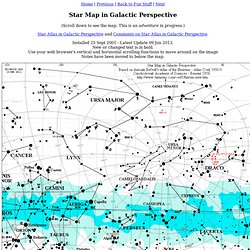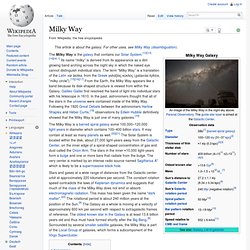

Maps of the Distribution of Galaxies. Galaxy Map. Maps of the Galaxy. A Galactic Chart. This map is a plot of all the stars visible with the naked eye.

There are approximately 9000 stars visible with the naked eye. This map is plotted in galactic coordinates - the plane of the Milky Way galaxy passes across the middle of this chart with the zero point of galactic latitude and longitude pointing directly at the galactic centre. The majority of the stars plotted on this map are within a thousand light years from us, which is only a minute part (less than 0.1%) of our galaxy, although there are a few naked eye stars which are probably beyond ten thousand light years. All of the 88 constellations have also been marked onto this map although constellations have no real significance - all constellations consist of stars that lie at very different distances. There is a negative version of this map which might be easier to print.
3D Galaxy Map. Sm-new. Home | Previous | Back to Fun Stuff | Next (Scroll down to see the map.

This is an adventure in progress.) Star Atlas in Galactic Perspective and Comments on Star Atlas in Galactic Perspective. Installed 25 Sept 2001 - Latest Update 09 Jun 2013. New or changed text is in bold. Use your web browser's vertical and horizontal scrolling functions to move around on the image Notes have been moved to below the map. The galactic coordinates now in use are not the same that were used on the 1972 map. To see a track for Halley's Comet in it's 12 BC apparition, overlaid on this polar plot, goto halley12.htm. The Star Map above is a colorized version of a pen and ink 1972 Star Atlas by R.S. The two-color Milky Way representation and other cartographic details are based on Antonín Becvár's Atlas of the Heavens - Atlas Coeli 1950.0 Czechoslovak Academy of Sciences - 1958.
Galactography. Milky Way. Stars and gases at a wide range of distances from the Galactic center orbit at approximately 220 kilometers per second.

Messier Objects in the Milky Way Galaxy. Orion Nebula. The Orion Nebula is one of the most scrutinized and photographed objects in the night sky, and is among the most intensely studied celestial features.[8] The nebula has revealed much about the process of how stars and planetary systems are formed from collapsing clouds of gas and dust.

Astronomers have directly observed protoplanetary disks, brown dwarfs, intense and turbulent motions of the gas, and the photo-ionizing effects of massive nearby stars in the nebula. Physical characteristics[edit] Trapezium Cluster. The Trapezium is a relatively young cluster that has formed directly out of the parent nebula.

The five brightest stars are on the order of 15-30 solar masses in size. They are within a diameter of 1.5 light-years of each other and are responsible for much of the illumination of the surrounding nebula. Extrasolar planet. 2 January 2013: Astronomers state that the Milky Way may contain as many as 400 billion exoplanets, with almost every star hosting at least one planet.[1][2][3] An exoplanet or extrasolar planet is a planet outside the Solar System.

Around 1800 such planets have been discovered[5][6][7] (1783 planets in 1105 planetary systems including 460 multiple planetary systems as of 18 April 2014).[8] The nearest known exoplanet, if confirmed, would be Alpha Centauri Bb, but there is some doubt about its existence. Almost all of the planets detected so far are within the Milky Way; however, there have been a small number of possible detections of extragalactic planets.
As of March 2014[update], the least massive planet known is PSR B1257+12 A, which is about twice the mass of the Moon. History of detection[edit] Early speculations[edit] Milky Way Spiral Structure Mao. Milky Way Spiral Arms Map. Frames of reference (galactography) Galactic Coordinates. The Galactic Coordinate System The galactic coordinate system is the key to understanding where objects are located within the Galaxy.

It was established in 1958 by the International Astronomical Union and is useful for specifying an object's location relative to the Sun and the galactic core of the Milky Way. The galactic coordinate system is a 2-D spherical coordinate system with us (or the Sun) at its center. It has latitude and longitude lines, similar to Earth's. In fact, a good analogy is to imagine yourself standing at the center of a hollow Earth looking at the latitude and longitude lines on the Earth's surface. Galactic quadrant. A galactic quadrant, or quadrant of the galaxy, refers to one of four circular sectors in the division of the Milky Way galaxy.

Quadrants in the galactic coordinate system[edit] In actual astronomical practice, the delineation of the galactic quadrants is based upon the galactic coordinate system, which places the Sun as the pole of the mapping system. The Sun is used instead of the Galactic Center for practical reasons since all astronomical observations (by humans) to date have been based on Earth or within the solar system. Delineation[edit] 1st galactic quadrant – 0° ≤ longitude (ℓ) ≤ 90°[4]2nd galactic quadrant – 90° ≤ ℓ ≤ 180°[2]3rd galactic quadrant – 180° ≤ ℓ ≤ 270°[3]4th galactic quadrant – 270° ≤ ℓ ≤ 360° (0°)[1] Constellations Grouped by Quadrants[edit]
Galactic coordinate system. List of celestial bodies by galactic coordinate system.